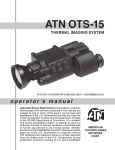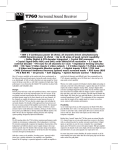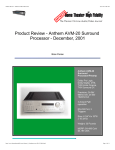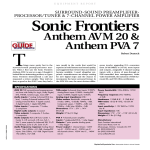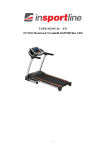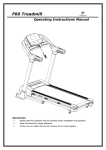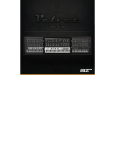Download AVM 30
Transcript
P R O D U C T REVIEW AVM 20 The AVM 30 (shown) incorporates design improvements for better performance. “… flawless … exquisite … a statement piece.” BY BRIAN FLORIAN VOL.8 • NO.4 INTRODUCTION Microwaves are a curious thing. Omnipresent, they buzz around us each day, carrying our cell phone conversations and some of the television we watch (among other things). But take the right wavelength at the right intensity, and the little buggers will heat your food, or even cook it if given the opportunity. Unlike a stove which relies on an exchange of molecular kinetic energy between an element and a pan, and subsequent similar exchange between pan and food, microwaves create the kinetic energy right in the food. Though microwave ovens are ubiquitous, most would-be chefs are unaware of the fact that microwaves primarily heat the moisture within food. It’s this little tidbit of trivia that makes microwave popcorn a reality. Popcorn kernels, dry as they are to the touch, have moisture trapped inside. When the moisture is heated sufficiently, it turns to steam and expands, forcing its way out of the kernel, and the proverbial “pop” ensues. How convenient that microwaves are so good at heating up moisture. I like kettle popped popcorn as much as the next guy, but you have to admit, those small paper bags of 3 minute magic are pretty darn cool. I concede that not everyone will consider the microwave/moisture/kernel relationship a fascinating revelation, but some (myself included) will dig that sort of stuff. If you want to sell microwave ovens though, the user manual had better talk about cooking times and not food-physics. The decoding and presentation of surround sound is pretty cool too. And like popcorn, most people don’t care what makes it happen, only that it does happen and that it happens nicely, yet there is always the group who get their jollies from the nuts and bolts of the thing. In that regard, Surround Sound Processors are a special challenge for manufacturers: they are, by nature, complex and must present a level of control worthy of the central role they play in a home theater. But at the same time they must come across as simple and above all functional while not sacrificing an ounce of performance. AVM 20 THE AVM 20 It follows therefore that interpretations of what a Surround Sound Processor (SSP) should be, what it should include, and what role it should play in a system are as varied as the manufacturers who create them. After having lived with and tested the Anthem AVM 20, I feel it is a pretty special piece because it embodies much of our interpretation of SSP art. Witness the current state of consumer electronics: technologies are in constant flux and as a result, the mass market names can’t help but yield short term investment products, continually replacing their own models with newer ones as buzz words and marketing gimmicks change. On the flip side are top-shelf names including Lexicon, Krell, Proceed, Theta, and our Stacey Spears own favorite: Meridian. All these portray a feeling of long term investment and those who can afford themselves such a tier of product often do so for that very reason. Take our editor’s $18,000 Theta Casablanca II: every process (AC-3, DTS, etc.) is on a card, cards which can be added and swapped at will. Stacey’s Meridian, while featuring card options for input and output, takes a more PC’esque approach by employing lots of generic computing power, and then rewriting or updating software as needed. This is peace of mind at a rather high price. Can state-of-the-art cost less? Can it still have provision for the future? Yes! The AVM 20 successfully weaves together fixed hardware with software processes, delivering an exquisite statement on the proverbial home theater center piece. Read on. THE GOODS I began my affair with the AVM 20, as I do so many, by unpacking it. The product is well built, solid, and robust. It’s heavy to the point you’d easily mistake it for a receiver. This weight is due in part to the beefy chassis whose fit and finish are like a fine exotic automobile’s, yet some weight comes from the two, count ’em two, separate transformers. There’s the main toroid and then a separate El core unit for standby power and other 12V needs outside of the audio circuit. The requisite black face is available in addition to the elegant silver of our review sample. A word on Inputs and Outputs. Well … maybe a bunch of words. Just for starters there are 7 basic inputs, each with stereo analogue audio (single ended), coax digital audio, composite video, and S-Video. Three of these have complete sets of analogue audio and video outputs to feed the record lines on those components. There are 3 Toslink (optical) digital inputs and one high-end AES/EBU digital input, any of which can be assigned to any of the 7 basic inputs. Further, there is a dedicated two-channel balanced input and a 6-channel (5.1) single ended input. A pair of component video inputs can be assigned to any audio line. Here’s a kicker: all inputs can be renamed to anything you like using letters and numbers to a maximum of 6 characters. For outputs, complete 7.1 sets are provided in both single ended and balanced formats. Both include two jacks for the center and subwoofer (10 outputs per set total). Stereo audio, composite, and S-Video outputs are provided for Zone 2 and Zone 3, while a pair of coax digital audio outputs are available with a variety of formatting options. Despite the abundance of jacks, and the fact that at first glance it looks overwhelming, they are actually easy to sort out: All inputs are on a black background, while outputs are all on a white background. See photo below. Finished? Oh no! There are three 12V trigger outputs (1/8˝ jacks), two infrared outputs (also 1/8˝ jacks), and a 12V terminal strip for IR receivers. A DB-9 RS-232 serial port gets the AVM 20 talking to home environment systems, and although it seems banal, antenna terminals are there for the built-in radio. The only spot on the back not populated has been conspicuously labeled “IEEE-1394/Phast Connection” so even that spot will get used up when a standard is laid down for it. 2 AVM 20 3 “The AVM 20 is a statement piece. A statement about all that is important, useful, and desirable in a surround sound processor. It’s also a statement about fair value. I suppose no preamp/ processor can be all things to all people, but the AVM 20 is the only one I know of that at least has a shot at it.” model of chip used by Sonic includes Dolby Digital and DTS software routines in on-chip ROMS. Other processes such as bass management, time alignment, and all the THX Home Cinema items are stored in external ROM chips (see ‘DSP Board’ photo below). This software can be changed and updated using a computer and a download from Sonic’s website. THX AND THE AVM 20 The primary, numero uno directive of THX’s surround sound processor spec is to account for, compensate for, and otherwise address the simple fact that a home theater is fundamentally a different space than that of a commercial, 200 seat cinema. A THX Surround Sound Processor includes several functions, collectively known as THX Post Processing, which are applied to the soundtrack after Pro Logic, Dolby Digital, or DTS decoding when “THX Home Cinema” is invoked by the user. The AVM 20’s design is a little like a personal computer in that it is based on a main board with various daughter cards. A veritable highway of audio, everything gets funneled through the big main board, so Sonic Frontiers (Anthem’s mother AVM 20 CONVERTER BOARD company) spent a great deal of effort in its design. It is comprised of four layers, with power and ground each getting their own plane. “The AVM 20’s sound is refined and Rather than let a computer draw out the ground plane, Sonic did exquisite. In what I heard, nothing could it manually, a process which took months of work, but they feel it is well worth it for the audible improvements. The main board be described as incorrect. Never did I manages all the audio ins and outs, while a completely separate think ‘if only it was a little more (or less) board manages the video I/O. Daughter boards which feed the main board include the DSP board and the such-and-such’. The sound was converter board. intrinsically satisfying.” Analogue to digital conversion (A/D or ADC) is done by a set of AK5383 ADCs running at 24 bits/96 kHz. These are two-channel ADCs, and you can see the set of three on the daughter card (see ‘Converter Board’ photo above). Three are necessary for digitization of the 6-channel analogue input. The digital to analogue converters (DAC) are AK4382s running at 24 bit/192 kHz. Again, these are two channel units, so four of them cover a complete 7.1 output, while a fifth takes care of stereo signals and/or downconverted material being sent to Zones 2 and 3. AVM 20 DSP BOARD On the DSP board is the Motorola 56366, a 24 bit process/ datapath DSP chip which handles all the Dolby, DTS, and THX processing as well as all other digital audio manipulation. It really is the brains behind the inner workings. Here is where it’s interesting to make a distinction about hardware vs. software. The Motorola processor is the hardware, and the particular The AVM 20 includes all the elements required for the THX Ultra Surround Sound Processor designation. THX post processing is nothing new, and while we at Secrets are not warm and fuzzy about everything which falls under the THX logo, most of us do highly advocate THX post processing and consider it a requisite element for an upscale surround sound controller. The AVM 20 uniquely allows latitude on some THX elements, so a quick refresher of what THX implies, and how the AVM 20 executes it, is in order. Timber Matching alters the sound of the surround channels, accounting for the fact that sources behind us sound different from those in front. By making the surrounds sound more like the fronts, a more seamless sound space is created. Adaptive Decorrelation was originally created in the hey-day of Pro Logic. It prevents the mono surround channel AVM 20 from sounding mono by subtly altering the time and phase of the two surround speakers. Because 5.1 soundtracks can contain mono surround information at times, the circuit adaptively kicks in only as appropriate on such material. “The AVM 20 sounds good. REALLY good! One can easily get over-absorbed with the features and functionality of the AVM 20, but the sheer sound quality is not to be understated. … The AVM 20 is clean, comfortable, and free of impurities. … Vocals are natural, bass is defined, and there is detail without the hash which is all too common in SSPs. … Brass, such as trumpets and French horns, is something I had practically given up on prior to the AVM 20 … “ Re-Equalization applies a specific roll-off of high frequency information to address the fact that movie soundtracks made for a cinema have an overabundance of treble when played at home (cinemas are equalized to the industry standard X-curve, and high frequency information bleeds off more readily in the large space of a cinema). Re-Equalization is a must for a good movie presentation at home. Without it, we are compelled to turn down the volume in response to the uncomfortable treble, thereby missing the more subtle elements of the soundtrack. But in recent years, soundtracks are beginning to be remixed for home release with appropriate energy balance, requiring Re-Equalization to be disengaged. The AVM 20 is one of few THX processors that allow Re-Eq to be switched off independently of the other THX processes (THX Home Cinema and THX Surround EX). As of software version 1.10, the AVM 20 allows you to make this choice. Bass-Management is another gem that THX mandated way back when, and some form of it is now found in every Dolby Digital decoding processor. The crossover frequency and slopes for THX’s bass management were not picked out of thin air. It is comprised of a 4th order low pass (80 Hz) to the subwoofer and a 2nd order high pass to any main channel set as “small”. The mismatch of slopes is in anticipation of THX main speakers which exhibit their own 2nd order roll-off (2nd order + 2nd order = 4th order). The AVM 20 naturally provides the THX crossover but in light of many users not having THX speakers, the crossover point is selectable from 40 to 160 Hz in 10 Hz increments (the slopes remain the same). Best results will be obtained when selecting a crossover point handy to, but not below, the natural roll-off point of your speakers. For those who are concerned with having a different crossover point for each speaker, get over it. Although at first glance it sounds like a good idea, it can actually cause more harm than good and makes getting equal low end extension for each channel a real headache, not to mention how problematic it is to sum the output at so many crossover points so close together. “It delivers excellent analogue performance and treats such material with reverence. It offers eloquent control and misses no mark in terms of usability. Hard core digital and home theater aficionados will be downright giddy to get one into their personal movie palaces.” Time Alignment of the channels is something which is now somewhat common place, but which THX mandated early on. Unfortunately, THX does not mandate how a user goes about setting it, and we’ve seen some very expensive products with extremely poor means of setting delay (though if you manage to knife through it, they do work). The AVM 20 offers the simplest, most elegant, and comprehensive means of setting delay possible. You just tell the AVM 20 how far each and every speaker, including the subwoofer, is from the main seat in the room. You can choose feet (0.5 foot increments) or meters, and the AVM 20 handles everything else for you. Further, the speaker setup section allows you to distinguish between direct and dipolar speakers so that the AVM 20 can set its delay appropriately. Sound from dipole speakers incurs a natural delay to begin with, and the AVM 20 will account for this (a first for THX processors). In addition, any delay induced by the bass-management crossover is also accounted for transparently to the user. THX Surround EX is, for lack of a better phrase, the “real deal” when it comes to EX playback and has a few perks over the innumerable clones that are out there. For one, the AVM 20 processing is the genuine Dolby article, as first used in theaters. THX Surround EX responds to the “EX” flag on DVDs while still allowing you to override at any time (early EX titles do not have the flag). THX Surround EX also uses two outputs for the rear channel, promoting the use of two speakers. Even our own early experiments with EX found two speakers to be much preferred, as a single speaker collapses the surround effect and can sound unnatural. GET IN YOUR ZONE Functionally, the AVM 20 is in fact three independent preamps which share a pool of sources. This is the “path” concept. Any source can play along any of four paths. The “Main” path is the multi-channel surround sound processor. “Zone 2” and “Zone 3” paths are each two-channel preamps, each with independent volume. “Record” is the 4th path, without volume, for the purposes of recording. Any source can be playing on any path at any one given time. A source can be playing on more than one path at a time and the audio and video of a source can be broken up on the fly (i.e., you can watch one 4 5 AVM 20 source while listening to another). If a multi-channel source such as a 5.1 movie soundtrack is playing on a path other than Main, the AVM 20 downmixes the material to two-channel. This includes Dolby Digital, DTS, and even the 5.1 analogue input. Naturally, control is a key issue with such a multiple-personality piece. Our own professional control freak, Colin Miller, poured over the RS-232 (serial) command set which would be used by a custom or whole-home installer to talk to the AVM 20. His comments are shown below: FORM AND FUNCTION The display is a nice large illuminated dot matrix with two rows of information. The illumination of the display (and all front panel lights) is functionally inspired. There are three brightness settings, each of which can be set on a scale of 0 (off) to 15 (bright). The display will stay at the selected brightness level until you interact with it, at which time the display can go either to the next brightness setting up, or right up to high (your choice). After inactivity, the length of which you can set in seconds, it goes back down. Videophiles will especially appreciate this ability for the AVM 20 to disappear in a darkened room, without them prompting it to do so. Colin Miller – As a professional control freak, I very much like the command set in the AVM 20. The required length for each command is short, which makes for easy buffering on the output side, in case I want to load a whole bunch of commands into Each input has the option of getting a global delay. In other a single selection sequence without specifying a bunch of sepawords, the entire program is held back as little as 1 millisecond rate delays. In addition to the vast amount of control available or as much as 84. This is of particular interest to videophiles through the RS-232 port, which allows you to directly access who are running their picture through a line multiplier which almost any parameter you could think of, a nice feature delays the picture. With a global delay on the AVM 20, is that most of the parameters are number-based, audio and video can be in perfect sync. in terms of zone or parameter value, which makes string building very easy if you The AVM 20 knows what the time of day want to pull command values from, or is and what day of the week you’re on manipulate them with, variables. (which is more than I can say for INPUT INPUT FORMAT PATH/ZONE What I also like is that the command myself at times). Each zone has set is relatively straight-forward timers which can be set for weekand intuitive, not requiring any day, weekend, or a combination strange calculations to generate of both. As an example, I set it to the final string. Checksums can power-on at 5:15 pm to give the be fun to write a subroutine for, system a little time to warm up but sometimes it can become a before I get home and turn off at bit of a headache, particularly if midnight in case I forget. On the the protocol isn’t explained very MODE VOLUME weekend, the wake up time is 8:00 well in the first place. am. The active source at turn-on is selectable as is the volume level and I really like the ability to get feedback whether it is instantaneous or ramp-up. from the processor. Most commands can Music or a television turning on and off while be queried using a “?” as the parameter which you’re on vacation is an added deterrent to theft. opens up possibilities for really cool integration. Not many surround processors I work with allow that kind The AVM 20 provides the option for a center channel EQ, of feedback. designed to compensate for the effect of putting a speaker All in all, from a purely command side, the level of control available on the AVM 20 is a control system programmer’s dream. I, like most of my colleagues at Secrets, am not fond of video switchers. Given the option, I will always run video directly from source to display. But with a multi-zone controller as powerful as the AVM 20, it only makes sense to have it. The video switch boasts a published bandwidth of 100 Mhz (-3 dB) which should be sweet for DVD’s 480p. In pro-video circles, 3 to 5 times the bandwidth is regarded as being required for “safe passage”, questioning the AVM 20’s ability for 1080p material. However, to put it in perspective, not only was I unable to get good enough test equipment to check it but had I, I would have had no 1080p source to test with! Given that HDTV set top boxes roll off their output anyway, I’m not going to lose sleep over such technicalities. above a big flat surface, namely your TV. That’s not so new. What’s cool is that you don’t need a $1500 real time analyzer to dial in a conventional 5 band EQ. Instead, the AVM 20 provides pre-set EQs for various TV size ranges. Pick the range one size up from what your TV actually is and start making your way down until you get the clearest dialogue. Voila! In my setup it truly made for a better match across the front three speakers. Having a party in your living room/home theater? Try the AllChannel Stereo mode for music. It’s not just a copy of the fronts to the rear, which would cause nasty comb filtering while you enjoy the sushi hors d’oeuvres. No sir, Sonic thought this through. And although I’m not big on such things myself, there are a few acoustic simulations for stereo material such as Club, Hall, Stadium, Theater and the like. There is even an All-Channel AVM 20 Mono mode (the entire signal to all channels) and a true mono mode (featuring the lone center speaker). The Cinema Logic™ mode is Sonic’s own interpretation of a Matrix surround sound decoder which derives up to 7 outputs (plus subwoofer) from two-channel sources with the algorithm adapting to the particular speaker set-up being used. Personally I found it very pleasant for music material, but the lack of presence in the center channel seemed to break the relationship between visual queues and the associated audio when using it on 2 channel movie soundtracks or stereo television programming. In future software revisions, Cinema Logic™ will be expanded to include better channel derivation and separate modes for music and movies. PICK YOUR AUDIO FLAVOR Any analogue source, including the 5.1 input, can be designated as either Analogue DSP, or Analogue Direct. Analogue Direct as the name implies, is a purely analogue pass-through of the signal with only volume control applied. Analogue DSP implies that an analogue signal gets converted to digital for the purpose of bass management, delay, and any other signal processing such as Pro Logic etc. Note that this is a valid option for the 5.1 analogue input. The more progressive among you will rejoice that you no longer have to worry about the bass management and delay capabilities (or I should say deficiencies) of your DVD-Audio player. The more conservative folk will poopoo the very thought of digitizing the analogue outputs of DVD-A, but with A/D stages at 24 bits/96 kHz and D/A stages at 24 bit/192 kHz, the benefits of proper bass management, time alignment, and the center EQ more than outweigh the consequences of re-digitizing in my view. In addition to Analogue DSP and Analogue Direct, any of the 7 basic sources can be assigned as Digital which implies a digital input to the AVM 20. Digital input can be any flavor of Dolby Digital, DTS or PCM audio up to 24 bits/96 khz. Each source has its own individual 2 band EQ (bass and treble), and each has its own input level trim. Volume is managed by a Crystal CS33101, a digitally controlled analogue device. This in and of itself is not so unique, but the AVM 20 is one of the few SSPs to really harness the convenience of such a volume. For each of the paths, you can set what the volume will be at power-on (no nasty full-volume surprises). 6 You can also set a maximum volume for each path. Being that the AVM 20’s settings are password protectable, those with teenagers are already seeing the genius of this type of control. Even the headphone jack has independent power-on and max-volume settings. A pair of coax digital outputs are provided. These can be a pass-through of digital signals coming into the AVM 20, or if an analogue source is selected on the record path, they can be a digitized copy of the signal. In such case you can select the output to be 16 bit/44.l kHz (expected by most consumer digital recorders) or 24 bit/88.2 kHz. This last option will likely be supported only by pro gear or select PC sound cards, so why would you want it? Well, chances are the AVM 20 is a better ADC than your PC soundcard, so you could use it to bring in material at 24/88, giving lots of headroom in such programs as Sound Forge and CoolEdit to do EQs, noise reduction, and normalization before burning yourself a standard 16/44 CD. THE EXPERIENCE Interacting with the AVM 20 is a remarkably intuitive experience. When first getting acquainted with the AVM 20, particularly when setting it up for the first time, I recommend hooking it up to the television/screen whether you will be putting video through it or not. It won’t give you any more information than the front panel, but it will help you initially by showing you all the elements in a menu as opposed to one line at a time. After just a couple of times through it, I no longer needed the on-screen display. Everyday operations on the AVM 20 make sense. Input selection is direct, not a cycle, and pressing any of the input buttons will turn the AVM 20 on with that input selected (if it wasn’t already on). Buttons are clearly labeled. Press one and turn the master knob to make a change. Hit “THX” for example and turn the knob to select between on and off. Or press “dynamics” and use the knob to cycle through Normal, Reduced, and Late Night. The remote is fairly large. Indeed every function of the AVM 20 can be controlled with it, and it has built in codes for virtually any mainstream CD/DVD player, VCR, TV, Cable box, Satellite dish, and so on. With the abundance of buttons available, I found it covered more of my equipment’s functions than any other such “multi-function” unit I’ve ever seen. This comes at a small price though: The remote can only put on one hat at a time. It is either the “AVM 20 remote” or the “TV remote” or the “DVD remote” etc. as selected by the buttons at the very AVM 20 7 top. The exception is the volume control which you can set to always correspond to the AVM 20 no matter what other hat the remote has on. The buttons are a little mushy, leaving me uncertain as to whether I’ve pressed one or not, but it does illuminate whenever you are using it. It’s nice because there are so many buttons, and finding the one you want by feel would be next to impossible. You’ll still need to memorize which button does what since labels for many functions are not on the button but on the background and thus invisible in a dark room despite the button illumination. “Interacting with the AVM 20 is a remarkably intuitive experience. … Everyday operations on the AVM 20 make sense. … The remote is fairly large. Indeed every function of the AVM 20 can be controlled with it, and it has built in codes for virtually any mainstream CD/DVD player, VCR, TV, Cable box, Satellite dish, and so on. … I found it covered more of my equipment’s functions than any other such “multi-function” unit I’ve ever seen.” The AVM 20 is very responsive to commands from the front panel. The same requests from the remote deceptively seem slower, but that’s because of its mushy buttons. It is very quick to act on changes in the audio bitstream as you navigate through DVD menus and the like, locking on to the bitstream and changing mode as appropriate with ease. Initially there was some irregular “popping” when locking on to a bitstream, but as of software version 1.10, which incorporates recent bug-fix code from Motorola, the AVM 20’s behavior is flawless. The AVM 20, unlike the majority of AC-3 decoders, actually reads the “Surround Encoded” flag in two-channel Dolby Digital bitstreams and sets its playback mode accordingly. So if the flag is “Dolby Surround Encoded”. the AVM 20 goes into Pro Logic mode. Otherwise it will go into Stereo mode (though you can force Pro Logic playback if the occasion dictates). Any decent SSP will remember the playback mode selected for each input, but the AVM 20 goes beyond that, also remembering your selections for Dynamic Range Control, THX, and so on. For example, DRC can be “Reduced” for the DSS (satellite) input and “Normal” for the DVD. As per THX requirements, the AVM 20 does internally attenuate DTS material by 4 dB, equalizing it with Dolby Digital material at the default -27 dialnorm value (*for more information, see our article on “Dialogue Normalization”). The AVM 20 however does not provide a DTS music mode which would automatically *Articles can be accessed at: www.hometheaterhifi.com attenuate the LFE channel by 10 dB (*for more information, see our article on the “LFE Channel”). In reality, it is very easy to make level adjustments to any channel without disturbing the master calibration settings, so for the DTS CDs which require it, it is not hard to do. “ … The AVM 20’s behavior is flawless.“ AND, THE SOUND … The AVM 20 sounds good. Really good! One can easily get overabsorbed with the features and functionality of the AVM 20, but the sheer sound quality is not to be understated. Ever since Dolby Digital started becoming mainstream, I’ve said that a surround sound processor is in fact a DAC. And as such an evaluation of its sonic quality should be along the exact same veins as if one were discussing a CD player or dedicated outboard DAC. Next to your speakers, the processor is the most influential element on a home theater’s overall sound. The AVM 20 is clean, comfortable, and free of impurities. Forget the analogue outputs of your CD player. Unless you paid four figures for it, just feed the AVM 20 a digital signal and let it handle the rest! Vocals are natural, bass is defined, and there is detail without the hash which is all too common in SSPs. Dare I say, Supertramp on CD sounded awfully analogue, reminding me of my reel-to-reel copy from so long ago. Brass, such as trumpets and French horns, is something I had practically given up on prior to the AVM 20, accepting that a reproduction which would please me was a metaphysic impossibility. Then I dug out an old CD “John Williams conducts John Williams, The Star Wars Trilogy” and started calling and e-mailing people “You’ve got to hear these horns,” I preached. “They’re real!” I fed the AVM 20 some Chesky 24/96 DVD material and compared the sound when running it as Analogue Direct and Analogue/ DSP. I listened and listened and listened. … Then I finally got something: there was a miniscule difference in the treble. Not even enough to describe. I tell you honestly, in a single-blind test I would not be able to say which is which only that you were changing them. In a double-blind setting, I would probably miss the change all together. It’s that subtle. I can’t even tell you “good” or “bad”. Either way the detail, nuance, and subtle inflections were perfectly intact. The point is DVD-A will certainly not be “wasted” on the Analogue DSP setting, but if it bothers you mentally, rest assured the purely analogue stages will serve your material well. But under the circumstances, I say one would be foolish to give up the benefits of bass management, time alignment, and the center EQ. DACs aren’t the only thing. The AVM 20’s outputs are Op-Amps of renowned pedigree: no less than Burr Brown OPA-2134s. I almost hesitate to say “op-amp” because of late there has been some renewed criticism of them as output stages with the alternative being stages made from discrete components. AVM 20 Sonic is not at all ashamed and cite their selection of the Burr Brown units as not just ‘good enough’, but as a large contributor to the AVM 20’s sound. Folks who have been in the biz for awhile will remember an article in [name omitted] magazine a while ago which trashed op-amps, conveniently leaving out the newest available at the time. While there are still all too many examples of “bad” op-amps, sonically, the best ones, like the Burr Browns, are just about ideal nowadays. A discrete circuit would obviously have a thermal advantage, but how much this matters comes down to how much current the load wants, and “better” op-amps handle the task in question without inducing a loss in sonic character. A discrete circuit with performance equal to the op-amps in the AVM 20 would end up being larger than a pack of cigarettes per channel, with an obviously higher cost not just in parts, but in production, inventory, etc. “I sincerely cannot call to mind being as impressed with the efforts of a manufacturer as I am with Sonic Frontiers and their AVM 20.” The AVM 20’s sound is refined and exquisite. In what I heard, nothing could be described as incorrect. Never did I think “if only it was a little more (or less) such-and-such”. The sound was intrinsically satisfying. You forget about the “wow” of audio and just plain enjoy the music or the movie. And isn’t that the whole point? SYNOPSIS AND CONSIDERATIONS FOR THE FUTURE The AVM 20 is a statement piece. A statement about all that is important, useful, and desirable in a surround sound processor. It’s also a statement about fair value. I suppose no preamp/processor can be all things to all people, but the AVM 20 is the only one I know of that at least has a shot at it. It delivers excellent analogue performance and treats such material with reverence. It offers eloquent control and misses no mark in terms of usability. Hard core digital and home theater aficionados will be downright giddy to get one into their personal movie palaces. I sincerely cannot call to mind being as impressed with the efforts of a manufacturer as I am with Sonic Frontiers and their AVM 20. Three grand isn’t chump change, but when you consider what the AVM 20 is and what it does, the word “bargain” or “steal” is not out of place. Get to know one as soon as you can. Sonic Frontiers has demonstrated a genuine commitment to the product’s life span by refining the AVM 20 over the last few months since its introduction via the 1.10 software update. Owners can look forward to 1.20 which will add more features to the AVM 20’s repertoire. Like all Motorola DSPbased units, the current crop of chips simply do not have the wherewithal for Pro Logic II processing, but they (Motorola) are working on it. Sonic is thus planning a 2.0 version software to accompany a replacement DSP board (availability rests on Motorola’s shoulders) which will add Pro Logic II and DTS ES among other things. The cost of new units at that point will go up by the cost of the upgrade, so there is no reason to hold off buying one and enjoying it right away. “All in all, from a purely command side, the level of control available on the AVM 20 is a control system programmer’s dream.” We will be following Sonic’s development of the upgrade and will publish a report on it when available. 8









